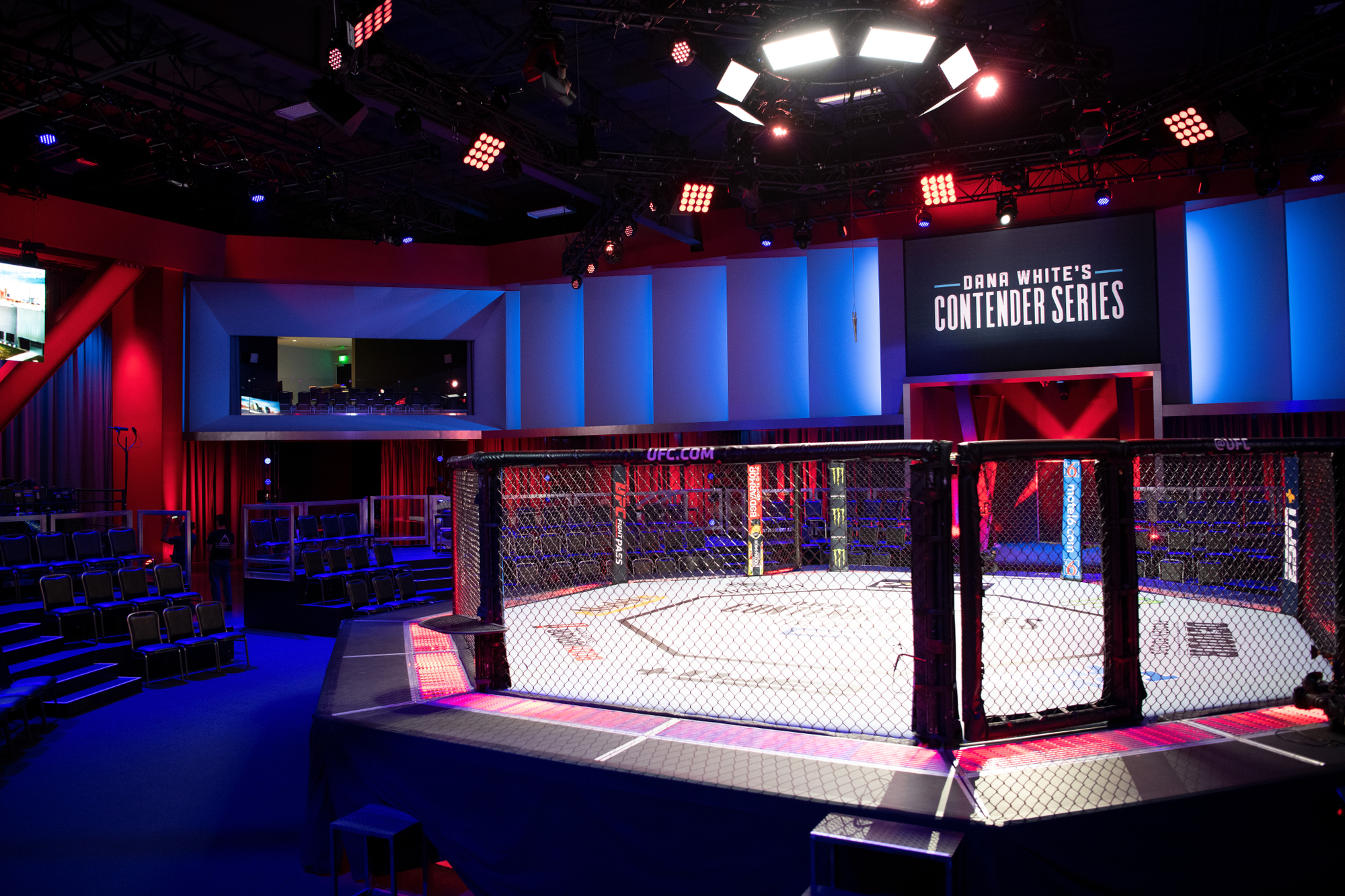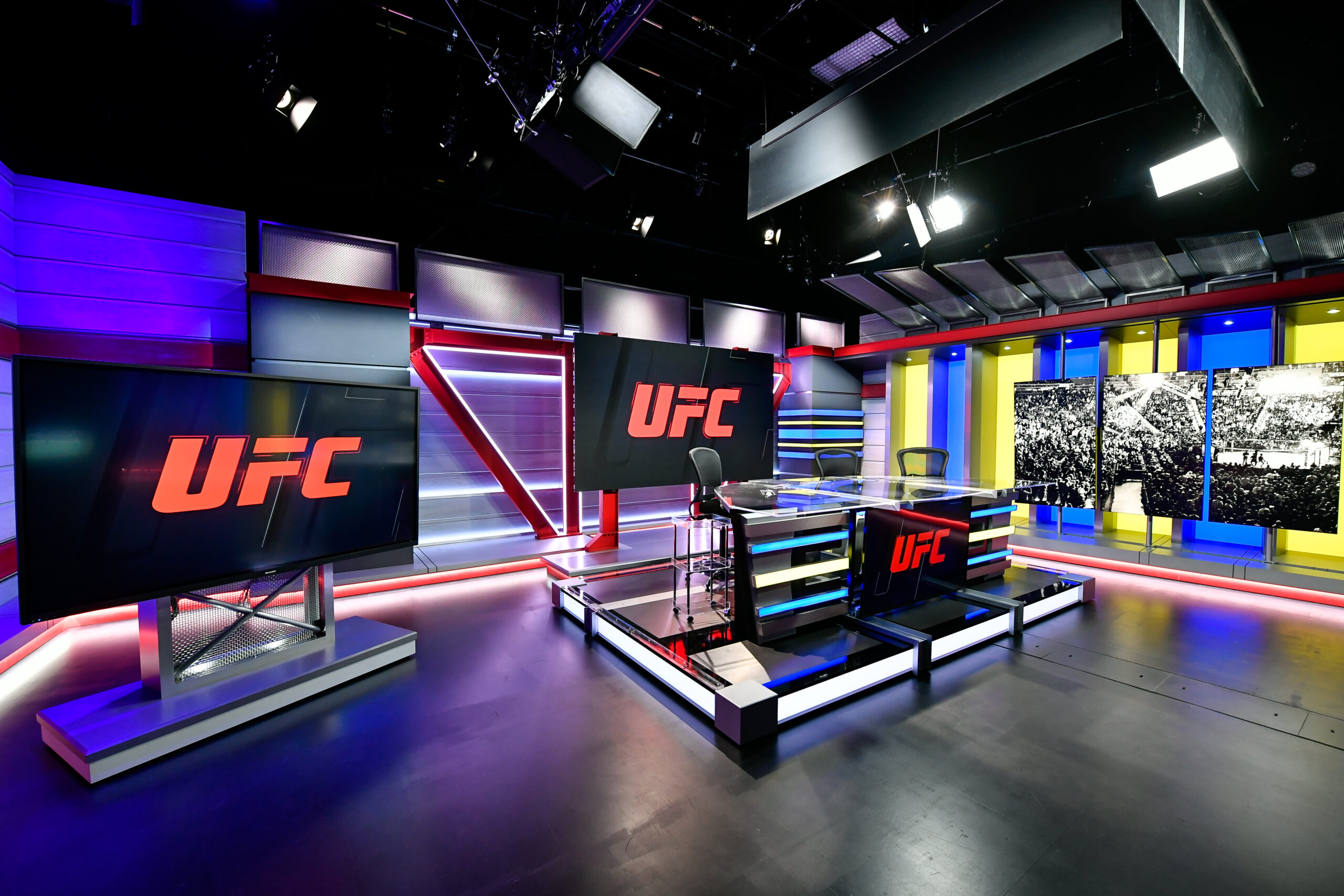UFC Turns 30: Craig Borsari Looks Back at Three Decades of Production Innovation Inside the Octagon
Story Highlights
This week marks the 30th anniversary of the UFC and, for Craig Borsari and his production and operations teams, what a wild ride its been.
On Nov. 12, 1993, the fledgling, no-holds-barred Ultimate Fighting Championship debuted with UFC 1 at the McNichols Sports Arena in Denver and what would transpire over the next three decades has been nothing short of transcendent. Today, the multibillion-dollar MMA promotion produces and delivers more than 40 live events per year to more than a billion TV households in over 165 countries and territories in partnership 60+ global broadcast partners.
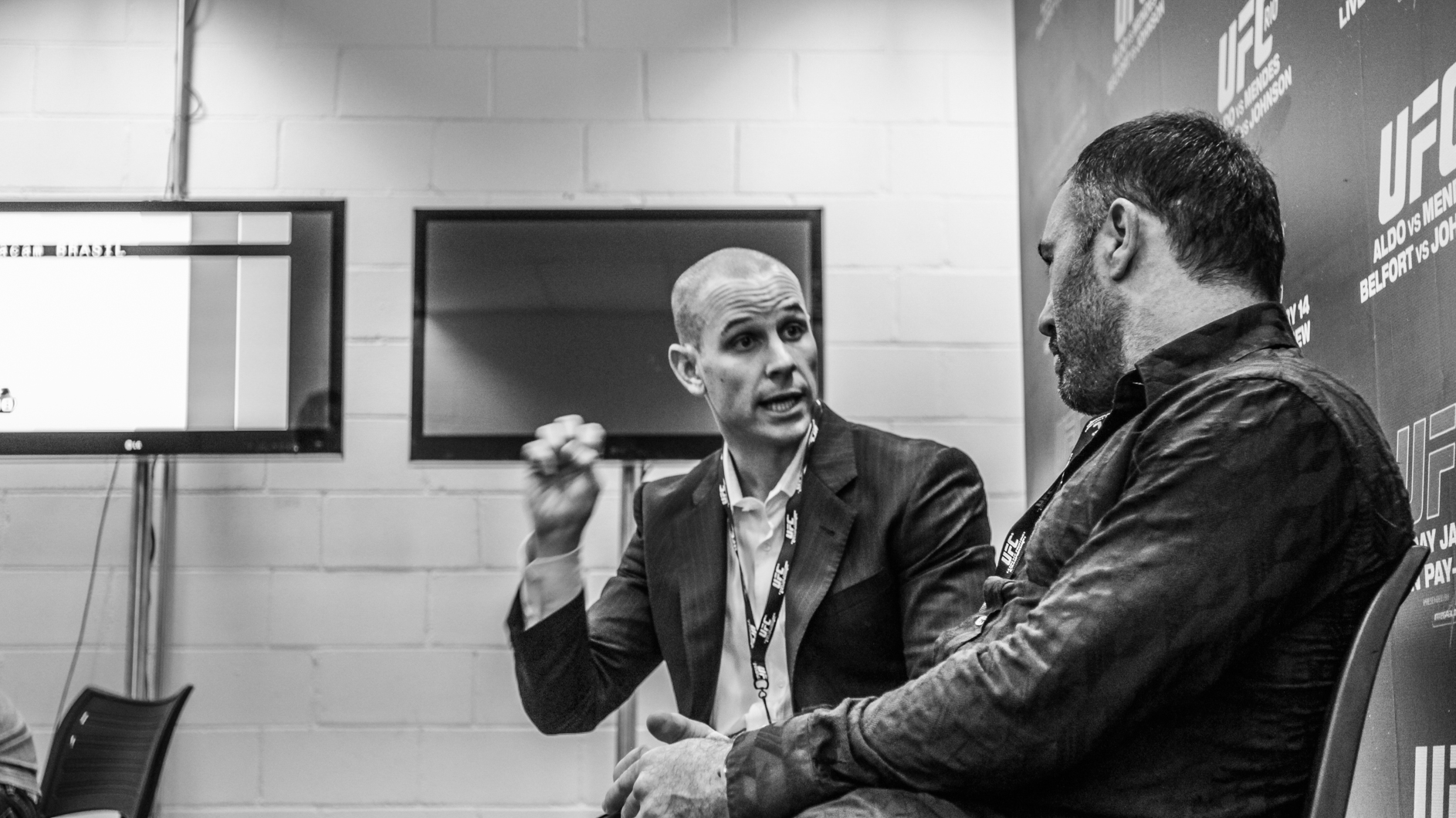
A youthful Craig Borsari, UFC Chief Content Officer and Executive Producer, with commentator Joe Rogan backstage at UFC 142: Aldo vs. Mendes I at HSBC Arena in Rio de Janeiro, Brazil on Jan. 14, 2012.
On UFC’s 30th birthday, SVG sat down with Borsari, who has been with UFC since 2005 and now serves as Chief Content Officer and Executive Producer, to take a look back at how the organization’s production prowess has grown by leaps and bounds during his time there, as well as key milestones and memories along the way.
What did UFC’s broadcast operations look like when you first started at the company?
When I started in 2005, it was vastly different and we had far fewer events on the calendar back then. In terms of the production complement, it was very scaled down. We had a single mobile unit and a lot less cameras and EVS [replay systems]. It was just a simple eight-camera execution with a very simple graphics package, and a lot less ancillary programming compared to the robust offering we have today. There was one full-time employee in the production department before I started and the rest of the team were freelance.
So what was the first UFC event you ever worked?
Everybody around here at the UFC always remembers their first event as an employee and mine was UFC 55 in 2005 at Mohegan Sun Arena in Connecticut. My head was definitely spinning for the first couple of years just trying to get a handle on everything.
And what was the first event where you realized that UFC had truly made it as a top-tier sports organization?
That’s a great question – I would have to say UFC 68 in 2007. That is when I really took a step back and said, ‘wow, the sky is the limit for this sport and this organization.’ That was Randy Couture versus Tim Sylvia [at the Nationwide Arena] in Columbus, Ohio. And I just remember the crowd roar and reaction to that fight was something that I had never heard before; it was just electric in the building. That night, I knew without question that there was a tremendous future for this sport and this brand.
Can you describe what UFC’s production facilities and staff looked like when you first arrived?
Our main office on Sahara Drive back in the day was a 20,000 sq.-ft. building and was pretty limited in terms of [production facilities]. We had five or six edit systems and a tiny little 30×20 sq.-ft. studio to shoot some very simple one-person interviews and short segments. And that was it. We were there all the way up to 2016, when we moved into our new building, which was 185,000 sq. ft. And then we took on an adjacent building a few years after that that added another 135,000 square feet, which is now UFC Apex. As we were growing in those early days, we were outsourcing a ton of our production for original programming because we just didn’t have the staff or the facilities back then to handle any of that.
And when did things begin to change and you started to bring production back in house?
Around the beginning of the Fox Sports era, we started to staff up with full-time employees. We also started to bring all of that programming that we had outsourced – our countdown shows, fighter profiles, documentaries – back in-house because we had the staff and the facilities to it. And then, when we opened the UFC APEX facility and the broadcast operations center, we were able to create pretty much any content that we could imagine. So to go from when I started – where we were lucky if we could execute a sameday 30-second promo in-house – to having 80 full-time employees in our production department and a state-of-the-art production facility has been a drastic change to say the least.
In 2011, UFC took a big step forward in signing a rights deal with Fox Sports. How did that change your team’s role and what was it like working with the Fox Sports folks?
The Fox deal was an incredibly exciting era for me because before coming to the UFC in 2005, I was working at Fox Sports. So it was a bit of a homecoming for me and I got to work with a lot of my friends and colleagues from the past. But more importantly, it was proof that UFC was really growing up – and growing up very quickly. We were finally going to be on a broadcast network with Fox in addition to being on their cable networks. I think it was during that period of time that we really started to play in the same space that all of the other major stick-and-ball sports were playing in. It was a bit of validation for those of us that been along on for the ride up until then and had had belief in the UFC for a long time. It showed that as a sport, as a brand, and as a company, we were ready to play at the highest level in sports media.
Then in 2019, UFC kicked off an even bigger deal with ESPN – how did that impact broadcast operations and what has that partnership been like over the past few years?
I think the ESPN represented logical evolution of the sport for us; having a partner like ESPN really allowed us to take the sport yet again to another level. It’s been an amazing partnership and we’ve really been able to grow the sport and the product in new directions as a direct result of [our partnership with] ESPN.
I think the one thing that sticks out with ESPN relationship that has been incredibly rewarding and beneficial – hopefully both to ESPN and definitely to us – has been the collaboration between our production groups. Glenn Jacobs [VP of MMA Production] has been at ESPN a long time and has been a great point person and collaborator with us. We are always bouncing ideas off of each other and we really operate more like a collective unit within the same company rather than a media rights holder and a production facility. We really collaborate like we are on the same team whether it’s studio programming, marketing assets, live event execution, or anything else.

UFC’s partnership with ESPN launched in 2019 and includes a plethora of content beyond the live fights (Photo by Chris Unger/Zuffa LLC via Getty Images)
We can’t talk about the evolution of UFC without bringing up the pandemic. You were among the first to bring back live sports events – both at UFC Apex and at Fight Island in Abu Dhabi. Can you recount how your team was able to pull those shows off under such challenging circumstances?
At first, we obviously came to a screeching halt just like everybody in the world did. But we actually were only idle for a few weeks because Dana came out and said, ‘Hey, we’re going to forge ahead here and figure out how to continue to produce live event programming in a safe way.’
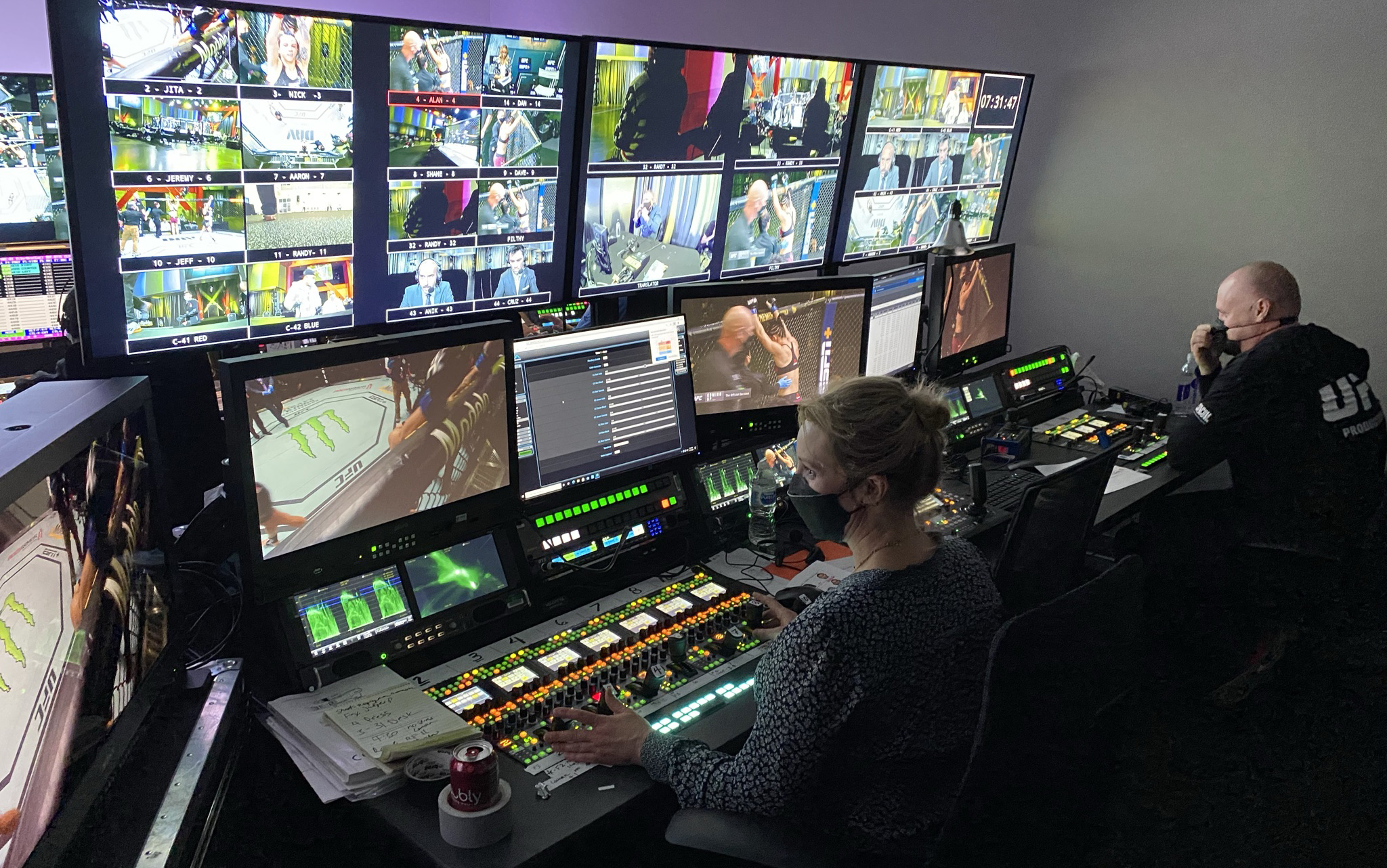
Despite monumental challenges, UFC was able to open the broadcast operations center at its new Apex facility in 2020 during the pandemic, become one of the first organizations to bring back live sports.
We were fortunate at the time that we were about 90% of the way done with the UFC Apex facility and its broadcast operations center when Covid hit. So our challenge at the time was how to get that final 10% of the facility commissioned and operating. It’s testament to Tim O’Toole [SVP, event production] and our entire team that we were able to get that building up and running. A lot of the equipment being commissioned was manufactured by companies that were outside of the U.S. So we had to commission a lot of the equipment remotely via FaceTime, which was not ideal, but we were able to figure it out. And once we did, we were able to then produce our live events out of Apex and deliver all our live content obligations to ESPN. So it was of course a horrible and challenging time, but we were fortunate to get that facility onboarded in time for us to get back up and running while [other leagues] still had to sit out.
And then Fight Island came about because Dana wanted to take our ability to continue to produce events during the Covid and include our fighters outside the U.S., who also had fight obligations. So Dana came up with the concept for us to get fighters into Abu Dhabi and Fight Island was born. That presented another challenge for our operations and production team to figure out how to replicate what we were doing at UFC Apex in Abu Dhabi.
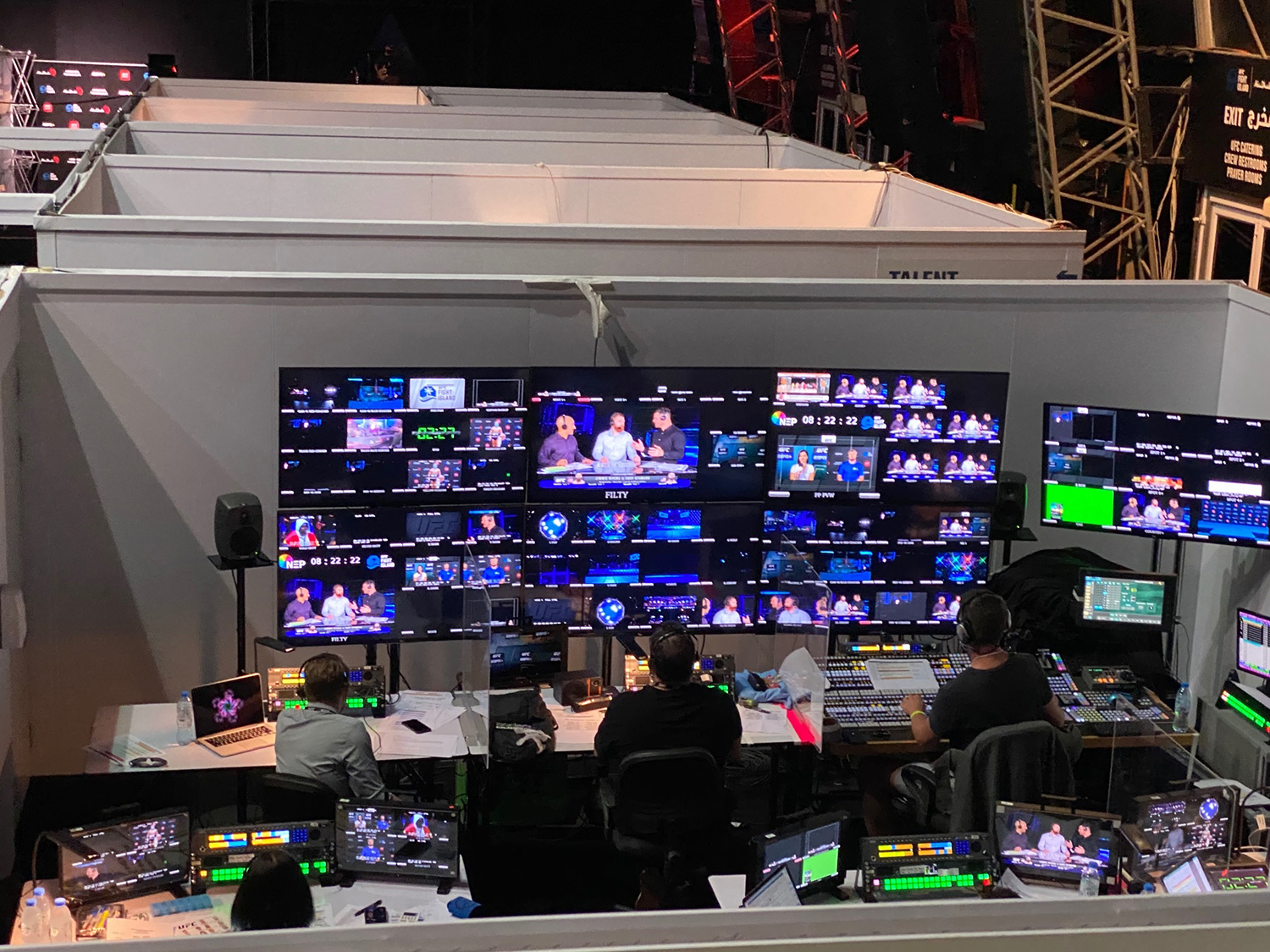
UFC created a series of modular production rooms inside the Flash Forum in Abu Dhabi to keep its crew safe during Fight Island productions.
And now UFC has entered into yet another exciting era with the UFC and WWE now officially under one roof as part of Endeavor’s TKO. How excited are you about working alongside WWE’s production team and what’s ahead for this new entity?
I’m incredibly excited. I think all of us on the UFC production staff have admired what WWE has been doing from afar, but we haven’t had a chance to get into the nitty gritty of how they’re able to execute their volume of shows to the level that they do until now. We’re in constant contact with Kevin Dunn [Executive Producer & Chief, Global Television Distribution] and Chris Kaiser, [EVP, WWE Television] over there, who head up their production operation. We are already sharing ideas, workflows, and technology and getting a sense of their approach to their product has been very enlightening. And I think the same goes for them when they look at [our operations]. We’ve visited each other’s shows on site and seen what they’re able to deliver a weekly basis with RAW and SmackDown programming. And they came to our [UFC 292 event in] Boston and saw how we handle our pay-per-view events. We are in constant communication on how we can make each other better. So it’s very exciting to continue those conversations and see how we can level up our production and offer them tips on how they might implement some things we do on the UFC side.

Craig Borsari, UFC Chief Content Officer and Executive Producer, with UFC CEO Dana White at the UFC Apex facility in Las Vegas.
What event are you most proud of during your nearly two decades at UFC?
There are so many to choose from, but I would have to say [UFC 129: St-Pierre vs. Shields] in Toronto. It was the first time we were in a stadium of that size and we knew we would have 50,000 plus fans in attendance, so it was a major undertaking for us. We had to figure out a way to take our arena show and transform it for a massive stadium, which was not an easy task. And the team did a phenomenal job leveling up the show and augmenting our lighting grid and our center hung [videoboard] with an LED cube that we created from scratch. All those fun things were incredibly rewarding. It was just a great team effort on the production side and, in terms of attendance, it’s still one of the biggest events we’ve ever done.
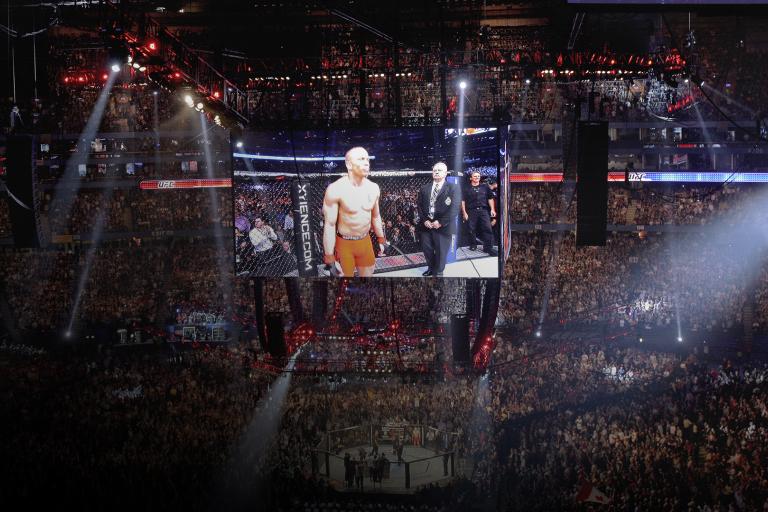
Jake Shields took on Georges St-Pierre for the Welterweight Championship at UFC 129 in the Rogers Centre on April 30, 2011 in Toronto. (Photo by Tom Szczerbowski/Zuffa LLC)
UFC events span the globe and you’ve found yourself in all kinds of crazy locales – what was the most unique?
I would say the very first time we went to Abu Dhabi [for UFC 112], where we literally created an outdoor arena on the desert sand right outside of Ferrari World [Theme Park]. We had never done an outdoor fight, so that was a challenge to begin with, but dealing with the heat, wind, and sand made it that much more difficult. We were getting sand getting in our camera lenses, the wind would pick up and blow things away, and the heat was a factor not only for our production group but our athletes as well. It was quite an effort to literally build out an event on desert sand, but we pulled it off.

For UFC 112 in Abu Dhabi, Borsari and his team created an outdoor arena on the desert sand right outside of Ferrari World Theme Park.
UFC has always pushed the envelope in terms of technology – what production tool or storytelling element would you say has had the greatest impact on the broadcast?
There are a lot of [innovations] that come to mind, but I would say the one that stands out the most is the JitaCam. You have seen JitaCams executed on a variety of different sporting events, but the way we implement the JitaCam is pretty unique because it acts both an amazing beauty and an essential [fight] coverage camera. It does an incredible job doing both. Our directors do an amazing job capturing pictures during walkouts and crowd shots after a fighter’s victory, but then our operators are good enough that it becomes a critical camera for fight coverage inside the octagon. Using it for both beauty shots and fight coverage allows us to really maximize the value of the camera.
From a storytelling perspective, what makes UFC unique from all other sports broadcasts?
I would say that because our sport involves two competitors, we’re able to dive in the background storytelling of both athletes in a way that gets you invested in one or both of them prior to their fight more than most other sports. And I think we’ve done a good job over the years figuring out a way to be succinct in that storytelling and, within two or three minutes, give you enough background on the two individuals understand the matchup. It’s a lot tougher to drill down deep for team sports and do profiles on each player. But we are able to do that throughout the night with deep storytelling on each matchup and each individual fighter prior to title card. So that certainly gives us an advantage and a unique angle in our broadcast.
To close out, how proud are you of what the entire UFC production and operations teams has accomplished over the past 30 years?
The single thing that I’m most proud of, without question, is the team that we’ve built in the production department. If you look at our original programming group led up by [VP, Production & Programming] Chris Kartzmark, the technical side that Tim O’Toole oversees, and the live events side that [head of production] Zach Candido oversees, there is a tremendous amount of teamwork that goes on across those three divisions. We have incredibly talented production staff that are always looking to push the envelope and push our productions to another level. And to have the amount of work on their plate on an annual basis and still have the desire to continue to look for ways to elevate our game, is just amazing. That’s part of the culture around here and part of the makeup of the production department as a whole. We are incredibly fortunate to have this team in place and I’m very fortunate to be able to work with them each and every day.


